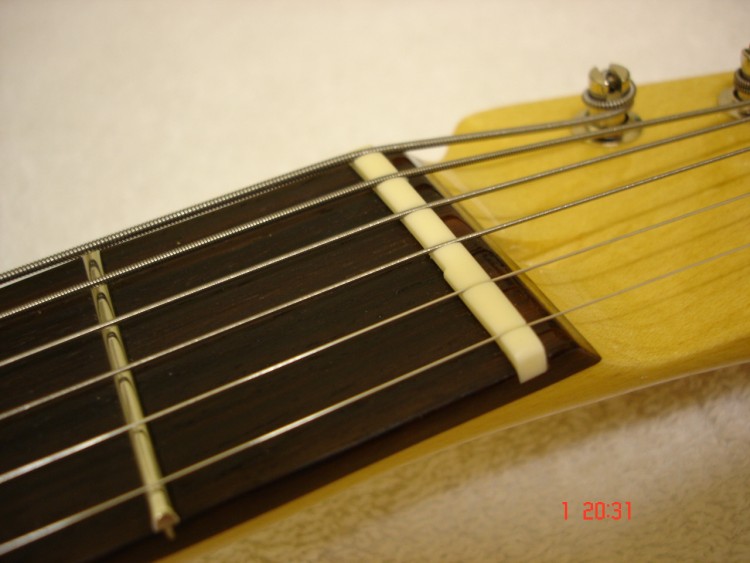The Funky Nut
NEWS – I am now offering electric guitar lessons https://guitarsetup.co.uk/guitar-lessons/
The Funky Nut FLOYD ROSE version is now available!!!!!


When you fret any note, on any string, you are bending the string…this will cause the note to be sharp. If you are very gentle with your finger pressure, the note will only be a bit sharp.
To further complicate matters, each string sharpens by a different amount when bent by the same distance. (The top E sharpens the least, the G the most …assuming a standard plain G)
You need to press a certain amount for the string to contact the fret and a bit more to hold it there. Most players will press quite a bit more as well, just to be sure. Many players press a lot more!
Traditionally, this has been compensated at the bridge, by moving the saddles away from the neck.
BUT…all the notes are being compensated…even the open strings. The open strings are the only notes that don’t get bent when you play them! Oops!
Don’t worry, help is at hand!
Nut Compensation
If the open strings are sharpened by the same amount as the fretted notes are (by moving the nut closer to the first fret), then open and fretted notes are in tune. (I know this seems a bit mad …sharpening the open strings!…of course, when you tune the open strings with your super accurate electronic tuner, it’s really the fretted notes that are being flattened by the same amount as they are sharpened when fretted…)
The bridge intonation is still required, only to compensate for each string’s stiffness.
The result is fantastically accurate intonation all over the neck.
OK, OK, I know that this has been claimed many times before (Buzz Feiten, Earvana, etc), but there are problems with these solutions.
BFTS…The same amount of nut compensation is applied to each string.
This means that the top E is over compensated and the G is under compensated. I think that this straight line compensated nut dates back to when BFTS installations where performed by removing some of the end of the fretboard, so that the nut would be closer to the first string. This is still the way in which Floyd Rose type locking nuts are catered for in a BFTS.
Earvana…This is more sophisticated than the BFTS nut, in that each string has a different amount of compensation. However, IMO, they have very much overcompensated! In addition, the A and E strings have more compensation than the low E, even though the low E sharpens by almost as much as the G when fretted.
In fact, much of my inspiration for the Funky Nut comes from the Micro-Frets guitars of 40 years ago. These featured a fully adjustable nut, where each string could be individually compensated…very clever, and way ahead of its time. So far ahead in fact, that nobody (well a few) seemed much interested. After all, electronic tuners were far from common and close enough was close enough.
So what’s so special about the Funky Nut?
- Each string has a carefully calculated amount of compensation.
- The nut is made from a low friction material (Graphtech Tusq XL).
- The installation is done very accurately (+ or – 0.002”).
- The Funky Nut looks good!
- Your guitar can be tuned with an electronic tuner or by ear (or any other method), without BFTS style “off-sets”.
- Even if the original nut was in the wrong place to start with (amazingly common!), the Funky Nut compensation will be correct for each string.
FAQ
- Are there any disadvantages to having a Funky Nut fitted?
No …Except that you have to pay to have it fitted… - Will it damage my guitar?
No…Only the same as having any other nut fitted… - Is it better than the other systems on the market?
Yes. IMO… - Can I get my local music shop or guitar technician to fit one?
No. (Not at the moment anyway) - What do Funky Nut users have to say about it?
“The Funky Nut rules!” - How much is it!
£130 fitted and set up.( If your guitar has appreciable fret wear, (or has suffered a poor quality fret dress), then a fret dress will be required (from £80)) - My guitar has a Floyd Rose trem with a locking nut. Can I have a Funky Nut?
Yes. This would be an extension attached to the locking nut, and made of low friction material. Not only would the intonation be improved, but also the accuracy of the nut slot heights and the open string tone too! (£180 fitted and set up for the Funky Nut for Floyd Rose)